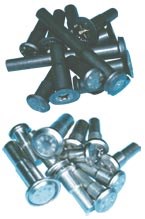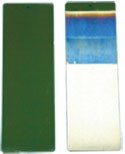Extreme Cleaning
Military components pose unique cleaning, stripping challenges
Some of the most difficult cleaning or stripping challenges involve removing “stuff” that was painstakingly engineered to remain in place for years no matter what it may run into. The fact that these surface coatings were developed to be resistant to common cleaning media or techniques makes the task of preparing substrates for subsequent operations difficult.
Examples of some of these challenges include:
- Solvent-resistant coatings such as chemical agent resistant coating (CARC)
- Halogenated organic coatings and fluorinated polymers such as PTFE, oils, greases and carbon deposits on engine components
- Molybdenum disulfide, graphite and boron nitride extreme-pressure lubricants
- Solidified glasses and warm/hot forming lubricants from forged and formed metal shapes
- Wear-resistant flame-spray coating materials such as tungsten carbide.
How do you efficiently remove these materials from components when you run into a “do-over” during initial manufacturing or need to remove them during maintenance, repair and overhaul (MRO) operations? Usually, components manufactured with these types of functional coatings are of high value and not readily scrapped when a defect occurs. Also, approved remanufacturing processes are required for the U.S. military’s RESET programs, which aim to save money and improve combat readiness by doing more repair and refurbishing work near where units are deployed. One unit is already employing the process to rapidly refurbish everything from M-16 rifles to state-of-the-art combat vehicles, reducing the time needed to get refurbished equipment back in the field by about one third.
Reset Cleaning
Dealing with defense material during RESET operations presents a variety of issues when it comes to cleaning. The size and complexity of U.S. Army tanks and other rolling stock is daunting. Overhaul of powertrain and suspension components requires removal of carbon, greases, oils, paints and other contaminants.
At the same time, reclaiming, rebuilding and remanufacturing such items has multiple benefits. Reclaiming and rebuilding are decidedly green activities, whether you’re talking about their positive environmental impact, the color of money, or a green light as in “ready to go.” It’s now more important than ever to the Department of Defense to manage the assets that used components represent. Leveraging the initial investment made in these high-technology devices helps to assure that combat needs are being met as economically as possible.
Here’s a look at some unique cleaning requirements common to military and aerospace applications. While some applications are more common to initial OEM manufacturing environments, there is some overlap in MRO where replacement component manufacturing relies on the same techniques as the OEM
Molten Salts: A Primer
Molten salt bath cleaning of components during remanufacturing is fast, thorough and versatile. The baths are unique in that they are 100% active chemical melts—there are no solvents, diluents, water or other components involved. They are liquid solely because of their operating temperature. There is no evaporation or loss of “liquid” from the bath at operating temperature because their vapor pressure is extremely low.
It’s important to note that there are no evaporative energy losses from the working bath, either. In many instances, energy requirements for operating a molten salt cleaning system are actually lower than many hot boiling aqueous cleaners they replace.
Molten salts also have high heat capacities—typically around 0.5 (water = 1). Thus they are an excellent heat source to bring workloads up to cleaning temperature in a few minutes or less with no chance of temperature overshoot that could damage components. Instead, the bath acts to absorb any heat and prevent overheating or “hot spots” and associated metallurgical changes during the process cycle.
This high heat transfer rate, combined with the high chemical reactivity of the bath, yields very short cycle times. Cleaning cycles can be as short as a few minutes, with cycle times of 10–40 min being typical. Ultimately, the size of the workload and component geometry, along with the contaminant being removed, dictate the length of the cleaning cycle.
Removal of Organic Coatings
Today’s high-performance coatings exhibit exceptional resistance to most conventional solvents and strippers. Solvents and stripping materials that are effective on CARC and similar compositions tend to be slow to react and often require secondary hand or mechanical work to complete stripping. High solvent resistance requires aggressive formulations and good coating flexibility reduces the effectiveness of abrasive blasting. Disposal of used stripping materials can also be problematic and may even be more expensive than the up-front material cost.
Thermochemical oxidation provides a fast, thorough, and controlled alternative for complete stripping of unwanted high-performance coatings. The combination of high temperature and high chemical oxygen availability very efficiently digests the original organic matrix. Even highly cross-linked or polymerized systems such as epoxies are removed in a matter of seconds to minutes:
(CxHyOz)n+ OH- + O2 → CO2 + H2O
(Polymer + alkali + oxygen→ carbon dioxide + water)
The carbon dioxide is scrubbed by the bath to form alkali carbonate. Stripping residues consist of 100% inorganic compounds, including the alkali carbonates produced by organic binder digestion and any other inorganics from the coating material such as fillers and pigments. The alkaline byproduct is a dense, rock-hard solid at room temperature. It can be dissolved in water and beneficially re-used to treat acidic wastes or readily neutralized with carbon dioxide or inexpensive mineral acids.
An added benefit of thermochemical stripping in a molten alkaline medium is in situ neutralization of acidic gases. During simple thermal decomposition of halogenated polymers such as fluorinated or chlorinated polymer systems, hydrogen fluoride or hydrogen chloride gases are generated. These acidic gases can not only etch or pit parts but can also attack furnace structures and form dangerous acids if absorbed in water. In alkaline molten salt processes, these by-products react immediately to form much less harmful compounds such as sodium fluoride or sodium chloride.
Cleaning of Engine Components
Another important application for thermochemical oxidation is cleaning of reciprocating engine heads, blocks and internals. Simple immersion into the molten salt bath, followed by application of brighteners and rust preventatives, results in inspection-ready clean components in less than one hour; this compares to cycles times of more than 12 hr for some alternative cleaning processes.
Molten salt cleaning also facilitates inspection. Unlike mechanical methods, which may peen component surfaces and hide microflaws and cracks, salt cleaning presents chemically-clean surfaces with no risk of masking defects. It also eliminates the potential for retention of residual blast media in engine components and other complex parts.
This unique set of process attributes makes molten salt cleaning well suited for overhaul/MRO applications for military components as well as high-performance aerospace coating removal. The speed and completeness of the process also allows its use for hooks, racks and fixtures in on-line continuous stripping.
Removal of Forming Lubricants
Oxidizing molten salts can very efficiently digest common high-performance forming lubricants such as molybdenum disulfide, graphite, and boron nitride materials. They can even remove molten glasses, which are used in their semi-liquid state as forging lubricants.
An added benefit to molten salt lubricant removal is simultaneous removal of any underlying scale. This permits the now-clean metal surface to uniformly react with subsequent pickling, anodizing and/or chemical conversion coatings.
An average Boeing 747 uses about 3 million fasteners in its fabrication, with about half of them being rivets that are typically fabricated by cold forming molybdenum disulfide-coated titanium alloy wire or rod. All traces of the molybdenum disulfide and other lubricants must be removed before the formed rivets can be anodized, heat treated and coated with various anti-corrosion or anti-seize compounds by either bulk or spray methods.
A completely clean substrate is essential so these small but critical fasteners can meet the performance demands placed on them. Through the combination of chemistry and temperature, molten salt processing can readily convert both organic and inorganic compounds into simpler compounds and/or elements.
An example of molten salt oxidation of an extreme-pressure lubricant is shown for molybdenum disulfide:
MoS2 + 4(Na,K)(OH) + 4O2 →
(Na,K)2 MoO4 + 2(Na,K)2SO4 + 2H2O
(Molybdenum disulfide + hydroxide + oxygen → alkaline molybdate + alkaline sulfate + water)
Graphite reacts with the same chemicals in a much simpler fashion:
C + O2 → CO2
(Graphite + oxygen → carbon dioxide)
CO2 + 2(Na,K)OH →(Na,K)2CO3 + H2O
(Carbon dioxide + hydroxide → alkaline carbonate + water)
Glassy lubricants rely on the affinity of molten salt cleaning for silica (SiO2) to form soluble alkaline silicate or water glass. The bath literally dissolves solidified glass from the surface forgings. As discussed above, the glass-coated forging also experiences surface scale conditioning during the deglassing operation.
Removal of Thermal Spray Coatings
Common flame spray or plasma spray coating materials include chromium carbide and tungsten carbide. Both are used extensively to produce wear-resistant coatings on sliding surfaces, cutting tools, and contact areas in jet or turbine engines.
During routine MRO activities, it may be necessary to remove these coatings to allow re-application of a fresh wear layer. After disassembly, select components are simply immersed into a molten salt bath to quickly convert the coating to alkali metal compounds:
Cr3C2 + (Na,K)OH + O2 →
(Na,K)2CrO4 + CO3 + 3H2O
(Chromium carbide + caustic alkali + oxygen → alkali chromate + carbonate + water vapor)
An analogous reaction takes place with tungsten carbide, resulting in the formation of alkali tungstate compounds.
The underlying components are typically made of high-performance stainless, nickel and cobalt alloys and are not adversely affected by exposure to the molten salt. Rather, an added benefit of the coating removal process is that scale conditioning takes place—any service oxides that may be present on the alloys are removed. Once clean, the components may be inspected, recoated and placed back into service.
Related Content
HVOF Coatings Stripper
This is a drop-in replacement for Rochelle salts that strips nickel or cobalt containing tungsten carbide or chromium carbide coatings.
Read MoreExpanding Custom Work Enables Top Shop to Shine
This six-person shop rallies together to offer diverse finishing jobs that are growing to include custom show parts for automobiles and motorcycles.
Read MoreHMG Paints Receives JOSCAR Supplier Accreditation
HMG Paints has received a Joint Supply Chain Accreditation Register registration mark.
Read MoreFinishing High Reliability, Function Critical Parts
From safety critical automotive and aerospace components to lifesaving medical micro-components and implantable devices, Indiana-based Electro-Spec finishes applications that require zero failure rates.
Read MoreRead Next
Delivering Increased Benefits to Greenhouse Films
Baystar's Borstar technology is helping customers deliver better, more reliable production methods to greenhouse agriculture.
Read MoreEpisode 45: An Interview with Chandler Mancuso, MacDermid Envio Solutions
Chandler Mancuso, technical director with MacDermid Envio discusses updating your wastewater treatment system and implementing materials recycling solutions to increase efficiencies, control costs and reduce environmental impact.
Read MoreEducation Bringing Cleaning to Machining
Debuting new speakers and cleaning technology content during this half-day workshop co-located with IMTS 2024.
Read More
























